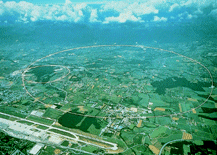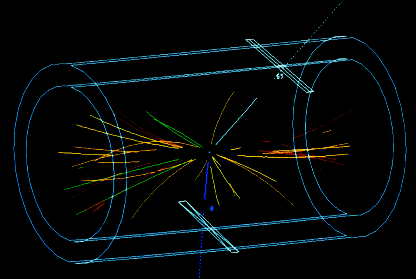A
GLANCE
TO
MODERN
PHYSICS
It was in the IV century A.D when the idea of a particle first came to light. Democritus
call it atom meaning indivisible. Nowadays we know that the atom
is indeed divisible. By the begining of the XX century, the british physicist
Ernest Rutherford realised for the first time that the stucture of the atom contains
a nuclei where most of its mass is concentrated. It is also known these days that
a cloud of electrons surronds this nuclei. Since early in the XX century attemps have been made
to identify the true fundamental particles that conform matter. That is those
physical entities which are indivisible.

The CERN accelerator in the Swiss-French
Border
In order to investigate the physics related to
the elementary particles huge machines have been built. These are the particle accelerators.
The end of these accelerators is to make collide beams of particles with a predefined
target and sometimes between them. The collision region is surrounded by detection instruments.
The function of these detectors is to study the debri produced by the collision
in order to identify possible new particles.

Particle tracks coming from a high energy proton-antiproton collision
as detected by the UA1 experiment at CERN in 1982. The tracks emerging
from the central detector are due to an electron-positron pair coming from
the decay of the first Z Boson ever observed. Several British groups were
involved in this experiment.
So far the known fundamental particles
are:
| LEPTONS | ANTI-LEPTONS | QUARKS | ANTI-QUARKS |
| electron |
positron | up |
s-up |
down | s-down
| | muon |
anti-muon | charm |
s-charm |
strange | s-strange
| | taon |
anti-taon | beauty |
s-beauty |
top | s-top |
These particles are the basis of all matter from this set all other particles
are form. However these are not the only fundamental particles that exists. There
exist also the force carriers, these particles are called bosons, and they are the
responsible of all the interactions in nature. And the neutrinos associated with
each of the three families of quarks. As of this day there are four known
forces governing the Universe: the familiar electromagnetic force, the also familiar
gravitational force, and the not so familiar weak and strong forces. Actually
we can talk of only three forces since it has been proved that the electromagnetic
force and the weak force are really just different aspects of a single one: the
electroweak force. The bosons carrying these forces are: the photon for the electromagnetic force;
the W+, W- and Z0 for the weak force; the graviton for the gravitational force; and
the gluon for the strong force.
As you may see this idea of simplicity (to have just one fundamental entity) is
far from being achieved. New supersymmetric theories attach another set of particles
and antiparticles to each of the fundamental particles mentioned above.
In this chaotic scenario, a new theory has recently emerged: the String theory and its supersymmetric
counterpart: Superstring theory. These theories are achieving what seemed to be
impossible: to have one single entity describing all known matter: the strings!
Strings and Superstrings, just like any violin string, can vibrate and form melodies,
the notes of the Strings and Superstrings are different states of matter, some
describes for example the gravitons other vibrations describe the quarks, and so on.
Thus, these two theories are the best hope we have so far to reach the dream: to have
a unique theory describing the very nature of the Universe.
Later on in future editions of this section I will talk more on the fascinating subject
of strings and how they differ from the old particle point of view. In the mean time,
let us have a look at the Big Bang theory and how the Universe started!


|
| HOME |




